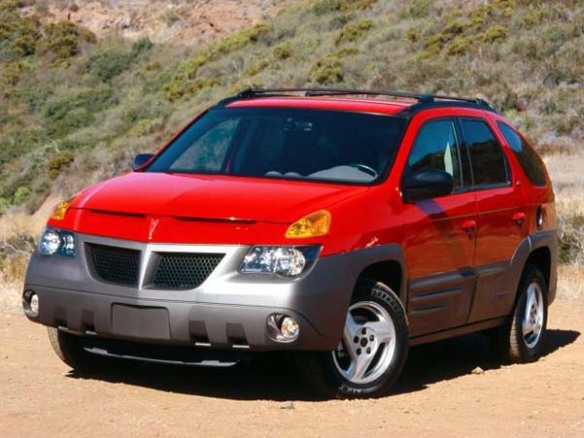 Welcome to the first of what will be several “obvious” inductees into the Archive of Automotive Horrors.
Welcome to the first of what will be several “obvious” inductees into the Archive of Automotive Horrors.
Alas, the Pontiac Aztek became an iconic symbol of everything that was heading in the wrong direction at General Motors at the dawn of the new millenium. Bad design, shoddy quality, and misdirected marketing all combined to doom what might have otherwise been a pretty good idea, but instead marked the beginning of the end for GM’s longtime and storied Pontiac Motor Division.
The easiest criticism to make about the Aztek was its awkward styling. Tall roofline, short wheelbase, odd fender-mounted marker/signal lights, and a front fascia that looked completely like the front ends of two totally different cars stacked together (or, as others would argue, looked like it had been inspired by a Dustbuster vacuum) – all combined for a public reception that met the Aztek with something just short of violent vomiting.
In fairness to the poor, ill-fated Aztek, the original concept design sported a slightly better design – a larger hood that incorporated the still-awkward looking grille, sleeker swept-back headlight pods, and aggressive rims and tires that begged for off-road trail duty. Designed and built around GM’s minivan platform (which was a great idea, because the world knows how incredible GM’s minivans were…. /sarcasm), the Aztek was supposed to be a “crossover” – oh, how I loathe that term – that offered Blazer-like utility with Grand Am-like livability. It was a pretty good idea that went horribly awry with bad implementation. Somewhere between the Detroit auto show and delivery to Pontiac dealer showrooms, design teams beat the front of the Aztek with an ugly stick, outfitted lower body panels with thick, ugly, plastic cladding (a 90’s Pontiac design cue that might as well have been the first nail in the coffin), and replaced the cool lunar rover looking concept rims with boring alloys. The gods were not pleased. The Aztek’s legacy will forever be its unattractive exterior design, and soon won’t be forgotten – you will find included on nearly every “Worst Cars” or “Ugliest Cars” list ever published – sometimes at the top. With other cars like the AMC Pacer and Ford Edsel routinely showing up on most of the same lists, that’s quite an accomplishment.
Curiously, the Aztek’s stable-mate sold by Buick – the Rendezvous – did not suffer from similar consequences. While the Rendezvous did not exactly go flying out of Buick showrooms, the little grocery-getter sold modestly well, with more conservative and upscale design, and a curious ad campaign featuring pro golfer Tiger Woods as the car’s driver. (As hard as it is to believe, it was not a Buick Rendezvous that Tiger was driving in that famous Thanksgiving weekend crash by his estate that imploded his marriage and golfing career.)
Additionally, the Aztek suffered from a multitude of quality and engineering issues. Many owners reported troubling electrical and electronic gremlins, as well as a tendency for the 3.4 liter V6 engine to run very hot (occasional overheating was a problem, as you can guess). The high-tech instrument cluster (which included GM’s pretty cool heads-up display) had issues, as well as body control functions that went bad (i.e. liftgate latches, power locks/windows, etc). Pontiac thought well enough to incorporate a small, Honda CRX-style, see-through vertical rear window glass on the rear tailgate to improve visibility – however, didn’t see fit to include a rear-window wiper, probably due to the narrow height of the glass area.
In spite of all of these things, and even with the extremely unpopular design, the Aztek still managed to find its way to some buyers and fans who managed to see through the flaws, and connect with the compact-sport-fun vehicle that GM was trying to market. Some outdoor enthusiasts favored the Aztek for its optional all-wheel-drive, a built-in cooler compartment, cargo flexibility options (with an interior wide enough to hold a 4-foot sheet of plywood – yes, that is right). Additional options gave buyers the opportunity to outfit their Azteks with bike racks, an air compressor, and an add-on tent that hooked up to an open tailgate which nicely turned it into a convenient camper (thus, totally completing that Dustbuster appearance).
In the end, the consumer market simply couldn’t get over the Aztek’s awkward looks, and after five years and a few minor trim alterations, GM brought Aztek/Rendezvous production to an end. As a footnote, the Pontiac Motor Division would end up folding four years later, victim not only to poor products like the Aztek, but also to a weak economy bringing GM to the brink of collapse. Last minute plans to convert Pontiac’s lineup to re-badged Holden-built automobiles came too little, too late. As it stands today in hindsight, the Aztek takes its place in history as a symbol of where GM went wrong, following the turn of the century.
More on the Aztek here: Aztekfanclub.com
